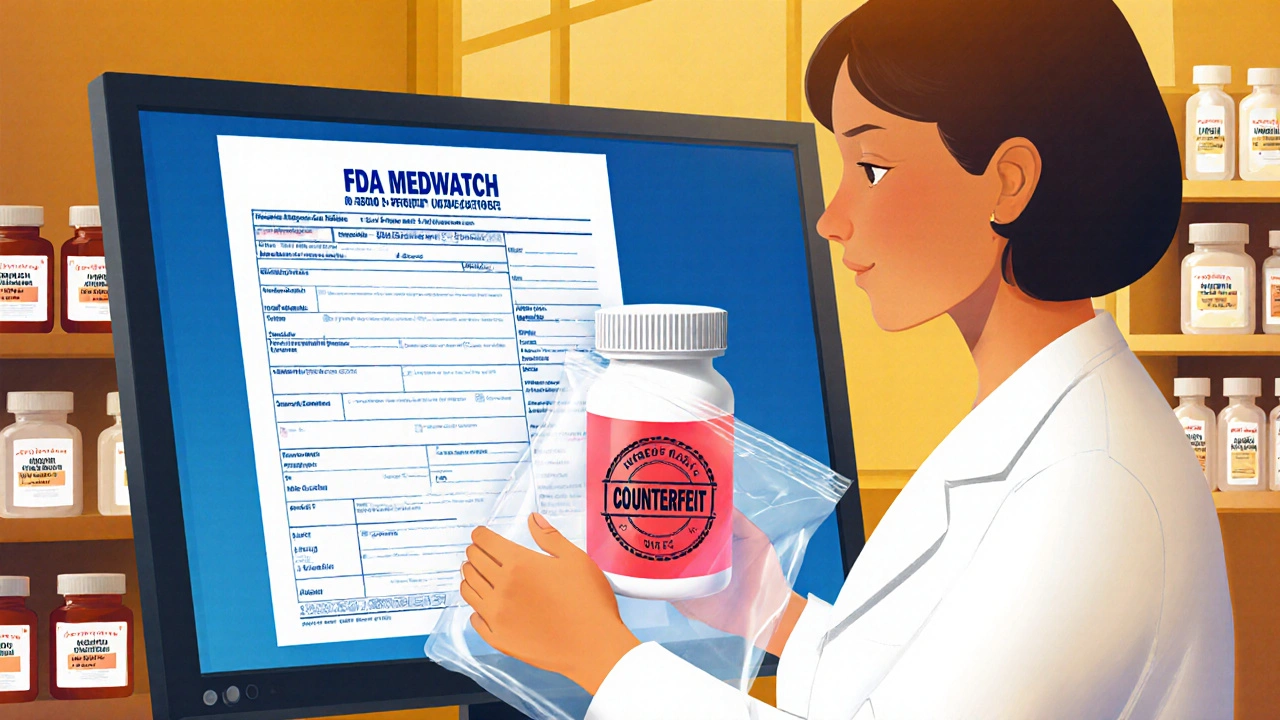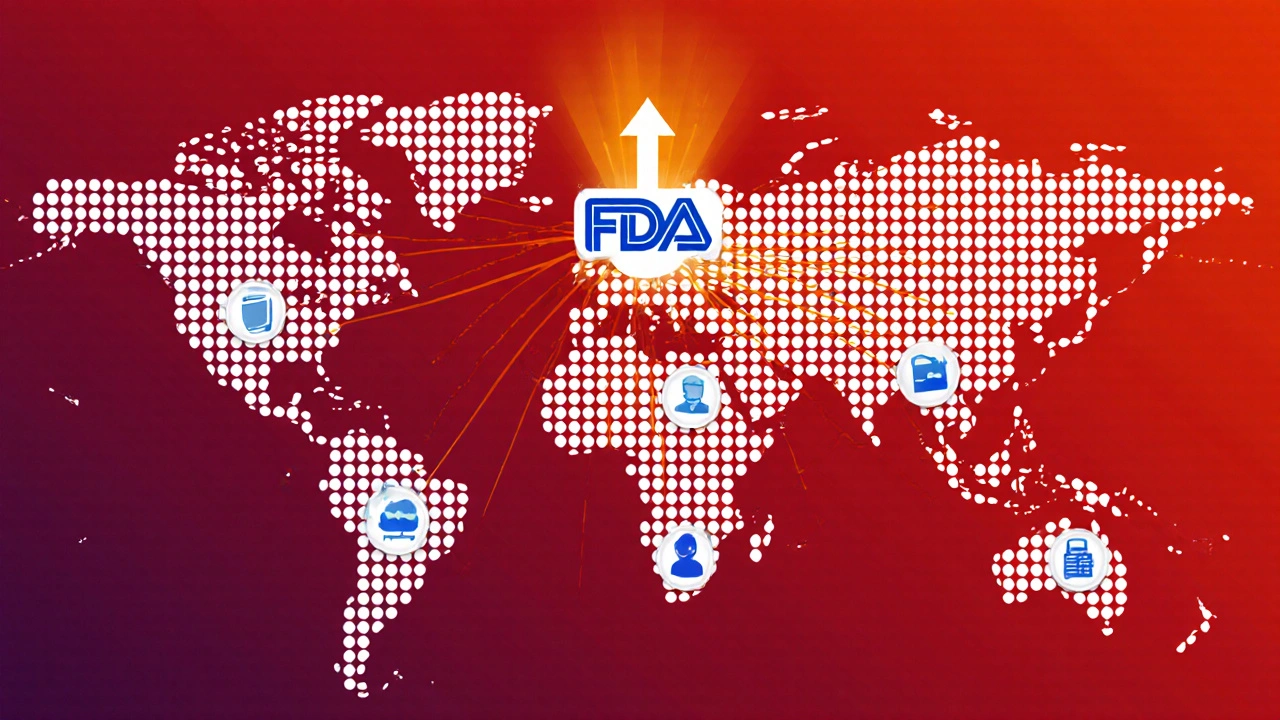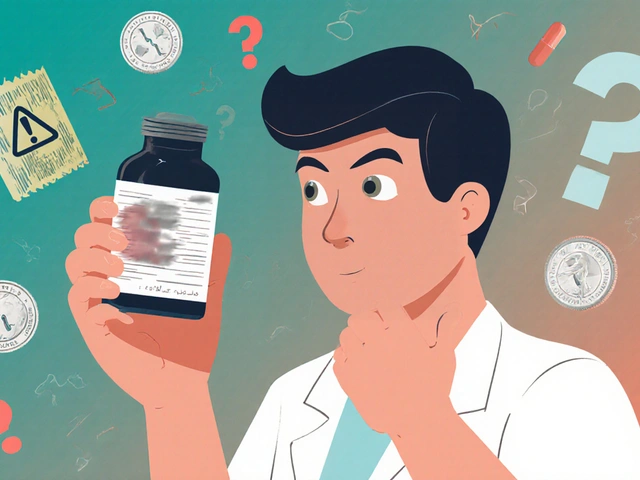How to Report Counterfeit or Tampered Medications: Step-by-Step Guide for Patients and Providers

Finding a pill that looks wrong-wrong color, wrong shape, wrong packaging-can be terrifying. You took it because you trusted the pharmacy, the label, the price. But now you’re not sure. Is this real? Or is it fake? The truth is, counterfeit and tampered medications are more common than most people think. In low- and middle-income countries, the World Health Organization estimates 1 in 10 medical products is substandard or falsified. Even in the U.S., the FDA removed over 2,300 counterfeit drug products from the market between 2015 and 2022, thanks largely to reports from people like you.
Reporting a suspicious medication isn’t just about getting your money back. It’s about stopping someone else from getting sick-or worse. A single report with a batch number and photo can trigger a nationwide recall. But knowing how to report, and where to report, is confusing. This guide cuts through the noise. You’ll learn exactly what to do, who to call, what info to save, and how to make sure your report actually leads to action.
What Counts as a Counterfeit or Tampered Medication?
A counterfeit medicine is fake. It’s made to look real but isn’t. It might have no active ingredient, the wrong one, or too much of it. A tampered product is real but was altered after leaving the manufacturer-maybe someone opened the bottle, swapped pills, or added something dangerous.
Here’s what to look for:
- Packaging that looks off: blurry print, misspelled words, wrong logo, mismatched colors
- Tablets or capsules that are different: unusual color, size, shape, smell, or taste
- Missing or altered safety features: broken seals, no holograms, no tamper-evident caps
- Expiration dates that don’t match the batch number
- Medication bought online from a site that doesn’t require a prescription
Don’t assume it’s just bad luck. If something feels off, it probably is. The FDA says 96% of online pharmacies selling drugs without prescriptions are illegal. That’s not a risk worth taking.
What to Do Right After You Find a Suspicious Medication
Don’t throw it away. Don’t take it. Don’t flush it. Your next step is preservation.
- Keep the pill, bottle, box, and receipt. Even if the box is empty, hold onto it.
- Take clear photos: front and back of the box, the label, the pills themselves, the seal, any writing or logos that look strange.
- Write down where you bought it, when, and how much you paid.
- If you got it from a pharmacy, ask for the lot number and pharmacy ID. They’re required to keep this info.
Don’t handle the pills more than you have to. If you’re worried about contamination, put them in a sealed plastic bag. You might need to hand them over to authorities later.
How to Report: U.S. Systems You Can Use
In the U.S., you have three main options. Each serves a different purpose.
1. Report to the FDA’s MedWatch Program
This is the most important step for consumers and healthcare providers. MedWatch is the FDA’s official system for tracking drug safety issues, including counterfeits.
- Go to www.fda.gov/medwatch and fill out Form 3500 online.
- Or call 1-800-FDA-1088 (1-800-332-1088).
- Be ready with: product name, manufacturer, batch number, expiration date, where you bought it, and your photos.
The FDA says reports with photos and batch numbers are 68% more likely to lead to a successful investigation. If you report within 24 hours, the product gets pulled from shelves 4.2 times faster than if you wait.
2. Report to the DEA’s RxAbuse Tip Line
If you suspect someone is forging prescriptions, diverting pills, or running an illegal online pharmacy, the DEA handles that. This is especially useful if you’re a pharmacist, doctor, or saw someone buying large quantities of controlled substances like oxycodone or Adderall.
- Call (571) 324-6499 (24/7)
- Or report anonymously online at www.deadiversion.usdoj.gov
Over 70% of successful DEA investigations in San Diego started with tips from the public. You don’t need proof-just suspicion. They’ve heard it all before.
3. Report to the Manufacturer
Pharmaceutical companies like Pfizer, Novo Nordisk, and Eli Lilly have dedicated anti-counterfeiting teams. If you bought a branded drug, contact them directly. They can trace the batch, check distribution records, and alert the FDA.
For example, Novo Nordisk logged 187 suspected counterfeit reports globally in 2022. Eli Lilly asks patients to report to their pharmacy, provider, and the manufacturer. It’s not extra work-it’s a safety net.

What If You’re a Pharmacist or Healthcare Provider?
If you work in healthcare, your responsibilities go beyond reporting. You’re on the front line.
- Don’t dispense a prescription you think is forged. Even if the patient insists.
- Call local law enforcement immediately if you see red flags: prescriptions written in multiple ink colors, different handwriting, call-back numbers that match the patient’s home phone.
- Report to MedWatch using Form 3500, but also use the FDA’s 3911 platform if you’re part of the supply chain. Manufacturers and distributors must report suspected illegitimate products within 24 hours under the Drug Supply Chain Security Act (DSCSA).
- Save everything: the prescription, packaging, any communication with the patient or prescriber.
The FDA found that 82% of wholesale distributors missed the 24-hour reporting window in 2022. That’s a legal violation. Don’t be one of them.
What About Online Pharmacies?
Buying medication online is risky. The National Association of Boards of Pharmacy found that 96% of online pharmacies don’t follow U.S. laws. Amazon, eBay, and social media marketplaces are flooded with fake drugs.
If you bought a counterfeit drug online:
- Report it to the platform. Amazon has a dedicated “Report Counterfeit” button.
- Save the order confirmation, shipping label, and product images.
- Then report to the FDA and DEA. Online sellers often operate across state lines-so federal agencies need to act.
Amazon alone received over 7,800 pharmaceutical counterfeit reports in 2022. Your report adds to the data that helps them shut down sellers.
What Happens After You Report?
Most people never hear back. That doesn’t mean nothing happened.
Here’s what usually follows:
- The FDA or DEA reviews your report and cross-checks the batch number with their database.
- If other reports match, they issue a public alert or recall.
- They may trace the supply chain back to the manufacturer, distributor, or online seller.
- In some cases, law enforcement raids warehouses or shuts down websites.
But here’s the hard truth: the FDA’s 2022 survey showed only 56% of consumers were satisfied with follow-up communication. Many reports go unanswered. That’s why it’s critical to report quickly, with details, and to report to multiple channels if you can.
One pharmacist in Texas reported a fake insulin product in March 2023. The FDA traced it to 142 bad lots within 11 days. That’s the power of a good report.

International Reporting: What If You’re Outside the U.S.?
If you’re in Canada, the UK, Australia, or elsewhere, you still have options.
- Canada: Report to Health Canada’s Office of Controlled Substances for controlled drugs. For other medications, contact your provincial drug program. Ontario pharmacists must email [email protected] with prescription details.
- World Health Organization: Use their Global Surveillance and Monitoring System. You can report through your country’s national health authority.
- European Union: Report to your national medicines agency (e.g., MHRA in the UK, ANSM in France).
The WHO’s system has tracked over 1,500 cases of fake drugs across 141 countries. You’re not alone.
Why This Matters More Than You Think
Counterfeit drugs aren’t just a scam-they’re deadly. In 2018, 107 people in Nigeria died after taking fake antibiotics. In 2021, fake cancer drugs in India contained only sugar. In the U.S., fake insulin, heart meds, and painkillers are showing up in rural areas and big cities alike.
The global counterfeit drug market is worth $205 billion. That’s not a number-it’s real people. Your report doesn’t just protect you. It protects your neighbor, your parent, your child.
And it’s working. The FDA increased its counterfeit investigation budget to $18.7 million in 2023. They’re hiring more staff. They’re testing AI tools that can spot fake packaging from a photo. They’re building a global reporting network that connects countries in real time.
But none of it works without you.
Quick Checklist: What to Do Now
- Don’t take the suspicious medication.
- Keep the pill, bottle, box, and receipt.
- Take clear photos of everything.
- Write down where and when you bought it.
- Report to the FDA via MedWatch (online or phone).
- If it’s a controlled substance or suspected fraud, call the DEA tip line.
- Report to the manufacturer if it’s a branded drug.
- If bought online, report it to the platform.
It takes 12-15 minutes. But it could save a life.
What if I don’t have the packaging or batch number?
You can still report. The FDA and DEA accept reports without batch numbers, but they’re much harder to investigate. If you don’t have the original packaging, describe the pill as best you can: color, shape, markings, size. Take a photo of the pill next to a coin for scale. Even basic info helps build patterns across multiple reports.
Can I report anonymously?
Yes. The DEA’s RxAbuse Tip Line is fully anonymous. The FDA’s MedWatch allows anonymous reporting too-you’re not required to give your name or contact info. But if you want a follow-up or to be notified of a recall, providing your details helps. You can always ask for your report to be kept confidential.
What if I already took the fake medication?
Stop taking it immediately. Contact your doctor or go to urgent care. Tell them you suspect the medication is counterfeit. Even if you feel fine, some fake drugs cause delayed harm-like liver damage from fake antibiotics or heart rhythm issues from fake blood pressure pills. Report it to MedWatch as soon as possible, even if you’ve already taken it.
How long does it take for the FDA to act on a report?
It varies. Fast reports (within 24 hours) lead to removal 4.2 times faster. The FDA says most investigations start within 3-5 business days. But public alerts or recalls can take weeks, especially if the product is sold in multiple states or countries. Don’t wait for a response to stop using the drug. Stop using it immediately and report.
Are there apps to report counterfeit drugs?
Not yet, but the FDA is testing a prototype smartphone app that lets you take a photo of a suspicious pill and automatically pulls the batch number, manufacturer, and product info from its database. In tests, it cut reporting time from 14 minutes to under 4 minutes. The app isn’t public yet, but it’s expected to launch in late 2025 or early 2026. Until then, use MedWatch online or call 1-800-FDA-1088.


Ross Ruprecht
Just read this and thought ‘lol why am I even surprised anymore’? Bought some Adderall off Amazon last year. Looked like chalk dust in a capsule. Still took it. Still alive. Probably should’ve called the FDA, but honestly? Too much work.
Lisa Detanna
As a pharmacist in rural Texas, I’ve seen this firsthand. Last month, a patient brought in ‘metformin’ that had no markings and smelled like burnt plastic. We held it, reported to MedWatch, and within 72 hours, the FDA flagged the batch. It came from a distributor in Florida that’s now under investigation. Don’t underestimate your report - it’s not just paperwork, it’s a lifeline.
Demi-Louise Brown
It is imperative that individuals take the time to preserve evidence and report suspicious pharmaceuticals. The integrity of the medication supply chain depends on public vigilance. Failure to act may result in irreversible harm to others. Documentation, including photographs and batch numbers, is critical to facilitating timely intervention by regulatory authorities.
Matthew Mahar
OMG I JUST REALIZED I GOT A FAKE LIPITOR LAST YEAR 😭 I THOUGHT IT WAS JUST WEIRD TASTE BUT NOW I THINK I MIGHT’VE BEEN POISONED??? I STILL HAVE THE BOTTLE IN MY CLOSET. DO I STILL REPORT IT??? I’M SCARED
John Mackaill
Interesting that the FDA’s follow-up satisfaction rate is only 56%. That’s a transparency gap. People report because they care - not because they expect a reply. But if the system could at least send a ‘we received this’ auto-notification, it’d go a long way toward trust. Small fix, big psychological impact.
Adrian Rios
Look, I get that this guide is thorough and well-meaning, but let’s be real - most people aren’t going to take 15 minutes to photograph a pill, dig up a receipt from 3 months ago, and fill out a 12-field form on a government website. We live in a world where people won’t even click ‘yes’ to cookies unless it’s pre-ticked. The real solution isn’t more reporting steps - it’s automated detection. AI that scans pill images, blockchain tracking from manufacturer to pharmacy, mandatory QR codes on every bottle. Until then, we’re asking the public to do the job of regulators who are underfunded and overstretched. And that’s not fair.
Casper van Hoof
The act of reporting counterfeit medication is a moral gesture, yet it exists within a structural vacuum. One is compelled to act not out of efficacy, but out of existential dread - the fear that one’s own body has become a vessel for negligence. The state, in its bureaucratic inertia, has outsourced vigilance to the individual, rendering the citizen both victim and sentinel. Is this justice? Or merely the architecture of abandonment?
Pramod Kumar
Back in Mumbai, I saw a guy die from fake insulin - just like that. No warning, no pain, just… gone. People buy meds from street vendors because they can’t afford the pharmacy. This isn’t just about ‘reporting’ - it’s about access. If you want people to stop buying fakes, make real ones affordable. Otherwise, you’re just asking poor folks to play Russian roulette with their meds.
Brandy Walley
Wow so now I’m supposed to be a detective too? I pay taxes so the government can handle this. Why am I the one holding the pill like it’s evidence in a crime scene? This is ridiculous. Also I think the FDA is just trying to look busy so they get more funding. I’m not sending photos of my Xanax.
shreyas yashas
my aunt in delhi took fake blood pressure pills last year. she almost died. we reported it to the local health office and they said ‘oh we get 20 of these a week’ and did nothing. so yeah, reporting feels like shouting into a hurricane. but i still did it. because someone’s kid might need that info someday.
Suresh Ramaiyan
There’s a quiet heroism in reporting a fake pill. You don’t get a medal. You don’t get a thank-you. But you’ve interrupted a chain of harm. One bottle, one batch, one life. It’s not about the system working - it’s about you refusing to let it fail silently. That’s the real power here. Not the form. Not the hotline. You.
Katy Bell
I reported a fake insulin last month. Got a generic email back saying ‘your report has been received.’ No update. No follow-up. But I saw a news article 3 weeks later about a recall for that exact batch. So yeah… I guess it mattered. Just… don’t expect a pat on the back. The system doesn’t do that.
Ragini Sharma
so i found a pill that looked like a skittle and i was like ‘is this adderall or candy?’ turned out it was both. now i have to go to the fda? i just wanted to get through my day. why is everything so hard???